Overview
Fatty liver disease
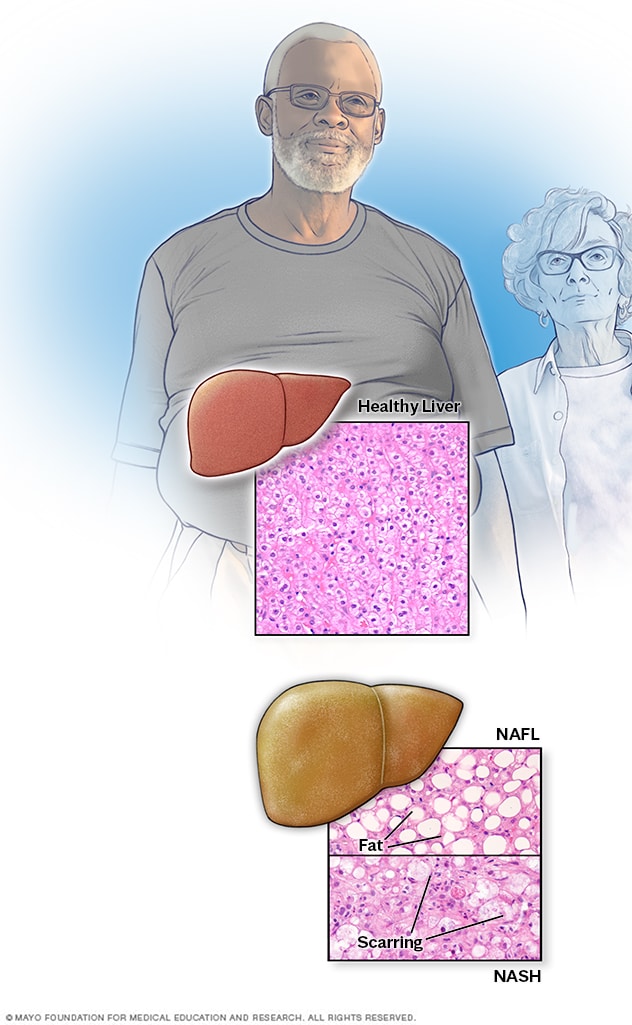
Fatty liver disease
Compared with a healthy liver (top), a fatty liver (bottom) appears bigger and discolored. Tissue samples show extra fat in fatty liver disease, while inflammation and advanced scarring are seen in metabolic dysfunction-associated steatohepatitis.
Metabolic dysfunction-associated steatotic liver disease (MASLD), formerly called nonalcoholic fatty liver disease (NAFLD), is a liver condition that affects people with excess weight, obesity or other metabolic conditions, such as type 2 diabetes, high blood pressure or high cholesterol. In MASLD, too much fat builds up in the liver.
MASLD is becoming more common, especially in Middle Eastern and Western nations, as the number of people with obesity rises. It is the most common form of liver disease in the world. MASLD ranges in severity from hepatic steatosis — sometimes called diffuse hepatic steatosis, or formerly fatty liver infiltration or simply fatty liver — to a more severe form of disease called metabolic dysfunction-associated steatohepatitis (MASH), formerly called nonalcoholic steatohepatitis (NASH).
MASH causes the liver to swell or enlarge. This is known as hepatomegaly. MASH also causes fat deposits in the liver, which causes liver damage. MASH may get worse and may lead to serious liver scarring, called cirrhosis, or even liver cancer. This damage is like the damage caused by heavy alcohol use.
Life expectancy varies depending on whether you have MASLD or MASH. Factors such as scarring and other health conditions also affect how long you can live with MASLD or MASH.
Products & Services
Symptoms
The liver
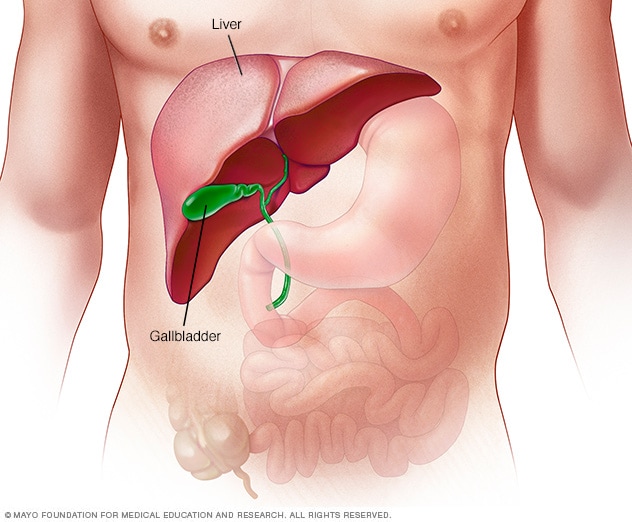
The liver
The liver is the largest organ inside the body. It sits mainly in the upper right part of the stomach area, above the stomach.
MASLD often has no symptoms. When it does, they include:
- Feeling very tired, also called fatigue.
- Not feeling well, known as malaise.
- Pain or discomfort in the upper right belly area.
Possible symptoms of MASH and cirrhosis, which is severe scarring, include:
- Itchy skin.
- Abdominal swelling, also called ascites (uh-SY-teez).
- Shortness of breath.
- Swelling in the legs.
- Spiderlike blood vessels just beneath the skin's surface.
- Enlarged spleen.
- A change in skin color on the palms.
- Yellowing of the skin and eyes, also called jaundice.
When to see a doctor
Make an appointment with a member of your health care team if you have lasting symptoms that worry you.
Causes
Experts don't know exactly why fat builds up in some livers and not others. They also don't fully understand why fat buildup in some livers turns into MASH.
MASLD and MASH are both linked to the following:
- Genetics.
- Being overweight or having obesity.
- Insulin resistance, which happens when the body's cells don't take up sugar in response to the hormone insulin.
- Type 2 diabetes, sometimes called high blood sugar or hyperglycemia.
- High levels of fats, especially triglycerides, in the blood.
These combined health concerns may contribute to liver damage. However, some people get MASLD even if they do not have any risk factors.
Risk factors
Many diseases and health conditions can increase your risk of MASLD, including:
- Obesity, especially when fat is centered in the waist.
- Type 2 diabetes.
- High cholesterol.
- High levels of triglycerides in the blood.
- Insulin resistance.
- Metabolic syndrome.
- Polycystic ovary syndrome.
- Obstructive sleep apnea.
- Underactive thyroid, also called hypothyroidism.
- Underactive pituitary gland, also called hypopituitarism.
- Growth hormone deficiency, which means the body doesn't make enough hormones to grow.
MASH is more likely in people:
- Older than 50.
- Who have certain genetic risk factors.
- With obesity.
- With diabetes or high blood sugar.
- With symptoms of metabolic syndrome, such as high blood pressure, high triglycerides and a large waist size.
It is hard to tell MASLD and MASH apart without an exam and testing.
Complications
Healthy liver vs. liver cirrhosis
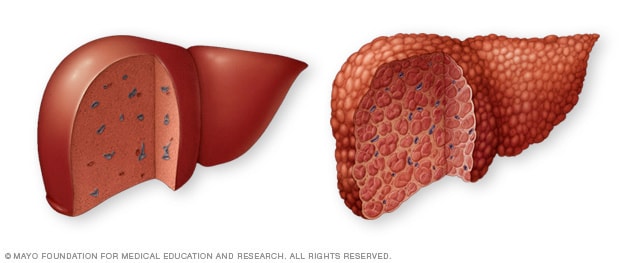
Healthy liver vs. liver cirrhosis
A healthy liver, at left, shows no signs of scarring. In cirrhosis, at right, scar tissue replaces healthy liver tissue.
Esophageal varices
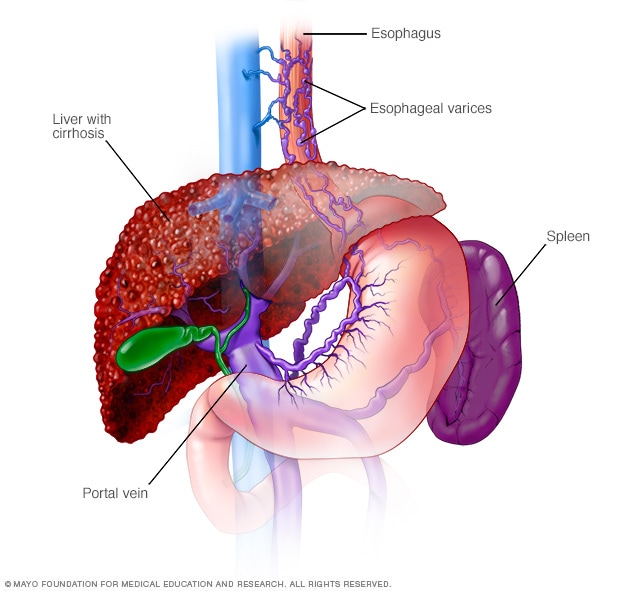
Esophageal varices
Esophageal varices are enlarged veins in the esophagus. They're often due to restricted blood flow through the portal vein. The portal vein carries blood from the intestine, pancreas and spleen to the liver.
Liver cancer
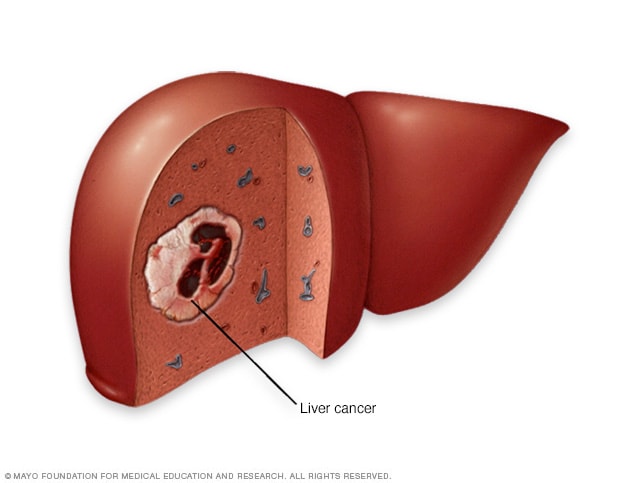
Liver cancer
Liver cancer begins in the cells of the liver. The most common form of liver cancer begins in cells called hepatocytes. This type of cancer is called hepatocellular carcinoma.
Severe liver scarring, also called cirrhosis, is the main complication of MASLD and MASH. Cirrhosis happens because of liver injury, such as the damage caused by inflammation in MASH. As the liver tries to stop inflammation, it creates areas of scarring, also called fibrosis. With ongoing inflammation, fibrosis spreads and takes up more liver tissue.
If nothing is done to stop the scarring, cirrhosis can lead to:
- Fluid buildup in the stomach area, called ascites.
- Swollen veins in the esophagus, called esophageal varices, which can rupture and bleed.
- Confusion, sleepiness and slurred speech, also called hepatic encephalopathy.
- Overactive spleen, known as hypersplenism, which can cause too few blood platelets.
- Liver cancer.
- End-stage liver failure, which means the liver has stopped working.
For many people with MASLD, the outlook is good, especially if they make recommended lifestyle changes. In fact, in some people, weight loss may help reverse MASLD. However, some people develop MASH, which significantly impacts life expectancy and health outcomes.
Prevention
To reduce your risk of MASLD:
- Eat a healthy diet. Eat a diet that's rich in fruits, vegetables, whole grains and healthy fats. One such diet is the Mediterranean diet.
- Limit alcohol, simple sugars and portion sizes. Avoid sugary drinks such as soda, sports drinks, juices and sweet tea. Avoid or limit alcohol, which can damage the liver.
- Keep a healthy weight. If you are overweight or have obesity, work with your healthcare team to gradually lose weight. If you are at a healthy weight, work to keep it by eating a healthy diet and exercising.
- Exercise. Be active most days of the week. Get an OK from your healthcare team first if you haven't been exercising regularly.
Dec. 12, 2025